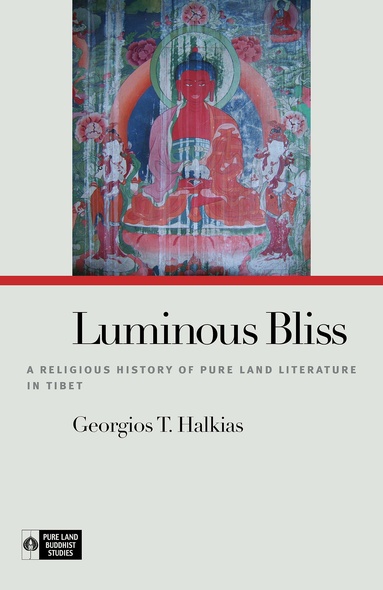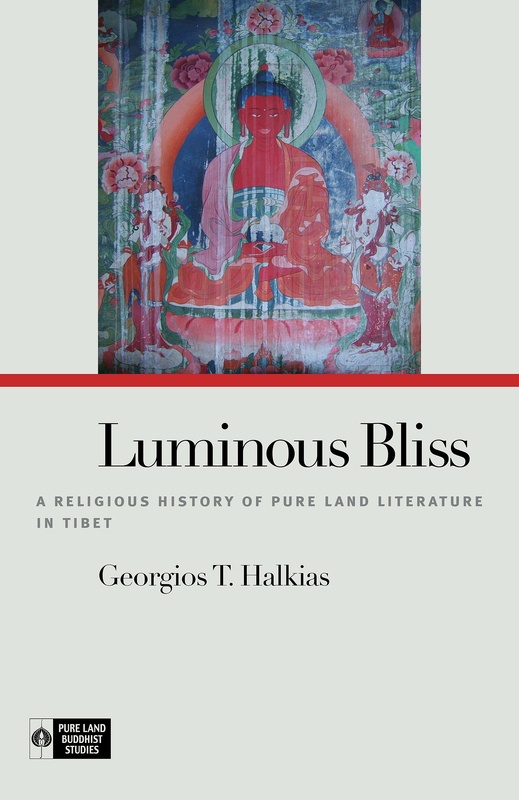
Luminous Bliss
A Religious History of Pure Land Literature in Tibet
With an annotated English translation and critical analysis of the Orgyan-gling gold manuscript of the short Sukhāvativyūha-sūtra
Pure Land Buddhism as a whole has received comparatively little attention in Western studies on Buddhism despite the importance of “buddha-fields” (pure lands) for the growth and expression of Mahāyāna Buddhism. In this first religious history of Tibetan Pure Land literature, Georgios Halkias delves into a rich collection of literary, historical, and archaeological sources to highlight important aspects of this neglected pan-Asian Buddhist tradition. He clarifies many of the misconceptions concerning the interpretation of “other-world” soteriology in Indo-Tibetan Buddhism and provides translations of original Tibetan sources from the ninth century to the present that represent exoteric and esoteric doctrines that continue to be cherished by Tibetan Buddhists for their joyful descriptions of the Buddhist path. The book is informed by interviews with Tibetan scholars and Buddhist practitioners and by Halkias’ own participant-observation in Tibetan Pure Land rituals and teachings conducted in Europe and the Indian subcontinent.
Divided into three sections, Luminous Bliss shows that Tibetan Pure Land literature exemplifies a synthesis of Mahāyāna sutra-based conceptions with a Vajrayana world-view that fits progressive and sudden approaches to the realization of Pure Land teachings. Part I covers the origins and development of Pure Land in India and the historical circumstances of its adaptation in Tibet and Central Asia. Part II offers an English translation of the short Sukhāvatīvyūha-sūtra (imported from India during the Tibetan Empire) and contains a survey of original Tibetan Pure Land scriptures and meditative techniques from the dGe-lugs-pa, bKa’-brgyud, rNying-ma, and Sa-skya schools of Tibetan Buddhism. Part III introduces some of the most innovative and popular mortuary cycles and practices related to the Tantric cult of Buddha Amitābha and his Pure Land from the Treasure traditions in the bKa’-brgyud and rNying-ma schools.
Luminous Bliss locates Pure Land Buddhism at the core of Tibet’s religious heritage and demonstrates how this tradition constitutes an integral part of both Tibetan and East Asian Buddhism.
If you are a scholar who specializes in either Tibetan Buddhism or in Pure Land studies, then you need to clear some shelf space and make room for this book. Georgios T. Halkias has written a trailblazing study of a Buddhist tradition normally associated with East Asia as it is found in Tibet, and this book is going to be the foundational text in this area for many years to come. . . . this book will stand for many years as a classic text and a rich reference source for scholars. The author is still a young scholar, and I look forward to seeing the ongoing results of his research program.
Halkias’ work truly is a rich and well-rounded pioneer-study of a comparatively neglected field that introduces the pure-land traditions of India and Tibet with considerable analytical versatility and compelling intelligence. A decade of sustained research on Pure-Land traditions inside and outside Indo-Tibetan cultural areas enables Halkias to draw on considerable historical and doctrinal details which allows him to fully contextualize and deepen findings explored in a number of noteworthy articles. . . . Luminous Bliss comprises a diverse and original body of previously unstudied sources and provides a rich nexus of departure points for further researchers.
Luminous Bliss is a tremendous addition to the neglected field of Tibetan Pure Land Buddhism and Pure Land Buddhism in general. The book displays the malleability of Pure Land Buddhism through its usage in tantric rituals in Tibet. Furthermore, Halkias relays the richness of Tibetan Pure Land literature. The amount of texts discussed, outlined, or translated in the book is wholly admirable and ensures that Luminous Bliss will be an important resource for current and future scholars.
Luminous Bliss is a tremendous addition to the neglected field of Tibetan Pure Land Buddhism, and Pure Land Buddhism in general. The book displays the malleability of Pure Land Buddhism through its usage in tantric rituals in Tibet. Furthermore, Halkias relays the richness of Tibetan Pure Land literature. The amount of texts discussed, outlined, or translated in the book is wholly admirable, and ensures that Luminous Bliss will be an important resource for current and future scholars.
If you are a scholar who specializes in either Tibetan Buddhism or in Pure Land studies, then you need to clear some shelf space and make room for this book. Georgios T. Halkias has written a trailblazing study of a Buddhis tradition normally associated with Eat Asia as it is found in Tibet, and this book is going to be the foundational text in this area for many years to come.
Halkias’ work truly is a rich and well-rounded pioneer-study of a comparatively neglected field that introduces the pure-land traditions of India and Tibet with considerable analytical versatility and compelling intelligence.
Luminous Bliss is a tremendous addition to the neglected field of Tibetan Pure Land Buddhism, and Pure Land Buddhism in general.
By providing both a sweeping historical overview of its development, and a detailed survey of its wide-ranging textual corpus, Luminous Bliss takes the study of the Tibetan Pure Land tradition to a whole new level. And in doing so Halkias reveals not only how the soteriology of Sukhavati shaped the practice of Buddhism in Tibet, but also how it informed Tibetan conceptualizations of the environment, society, and the state.
Not so long ago, ‘Pure Land Buddhism’ was often presented as a novel East Asian phenomenon, inspired perhaps by certain Indian Mahāyāna scriptures, but far removed in spirit from such distant antecedents. Recent scholarship, however, has demonstrated that trends relating to the aspiration for rebirth in the ‘Pure Lands’ were and in many cases remain widespread in Mahāyāna milieux, throughout their vast and varied geographical range. Georgios Halkias has performed a great service for current Buddhist studies by examining the record comprehensively and presenting a scrupulously detailed account, with particular reference to Tibet. This is an essential work for all serious students of Mahāyāna Buddhist traditions.
This excellent, comprehensive study of the Indian and Tibetan traditions of Amitābha’s Pure Land is a rich resource for understanding a historical development of the Pure Landtradition in these regions. Drawing on previously unexamined sources, Georgios Halkiasgoes beyond a mere recounting of historical, social, and cultural contexts in which the Pure Land tradition developed. He attends to the conceptual issues embedded in visionaryexperiences, rituals, liturgies, and soteriological missions of major Tibetan Buddhist figures who wrote on Amitābha’s Pure Land. This volume is a work of solid scholarship that promises to remain a seminal contribution to the understanding of the Pure Land tradition in India and Tibet.
Georgios T. Halkias specializes in Tibetan and Himalayan religions and history and has held research posts and fellowships in the U.K., at the Warburg Institute, the University of London, and the Oxford Centre for Buddhist Studies; in Germany at the Ruhr-Universität-Bochum; and the Jōdo-Shinshū Otani-ha Foundation in Kyoto. His publications include a number of articles on Tibetan and central Asian Buddhism, Himalayan history, and interdisciplinary studies in religion.




